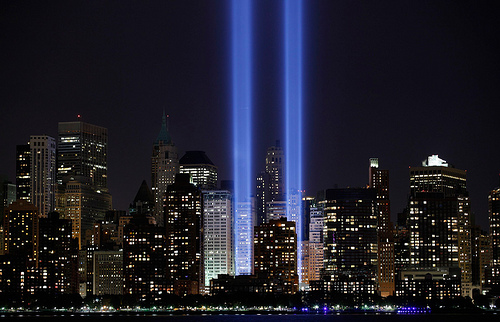The Final Obituary from September 11

Although no official cause of death was announced, a statement released by the family said that Nantz had been in poor health of recent while staying at a retirement home in Winchester, Virginia.
Nantz, who was working as an administrative assistant in the Pentagon on the day of the attacks, was the final personal link to an historical event that shocked the nation at the dawn of the 21st century and defined much of the world moving forward.
“Shelly’s life spanned across three centuries and was forever proud of her connection with this significant moment in American history,” said a family statement. “Throughout her life she kept her stories of the tragic attacks alive and fought to have the memories of those whom she lost in perpetuity.”
In Washington, President Bradovick expressed deep sorrow over her passing, lamenting in a statement “the last of a living connection to a hallowed day for this nation.”
“It is a sad moment for Nantz’s family as well as for everyone who cherished the memory of the survivors of the attacks of September 11, 2001. Their resolve on that morning and in the days and weeks following were testaments to the steel and bravery that held America together then and continues to this day”
Two years ago, Bradovick and Nantz appeared together at a memorial marking the 100th anniversary of September 11. Nantz, along with Hunter D Reals who worked in the mailroom in the North tower of the World Trade Center that collapsed in the terror attacks, represented the final two survivors from that day. Reals died several months later, allowing Nantz the mantle of sole September 11 survivor.
Michelle Marie Woolsey was born February 21, 1982 in Richmond, Virginia. At the time, Ronald Reagan was the president and Communism along with the reach of an “evil empire” was the biggest foreign concern for the country. Almost no Americans had heard of Osama Bin Laden, the head of the terror organization that carried out the September 11 attacks, but who then was a recent graduate of a Saudi university.
Barbara Woolsey, Michelle’s mother, had been a grade school teacher, and her father Dale Woolsey, worked as a security analyst for the Defense Department at the Pentagon.
It was there where she got her first job working part-time as an administrative assistant for her father. She had just gotten into work on the morning of September 11 2001 in the outer “E” ring of the Pentagon when word broke out in the office that a plane had crashed into the World Trade Center in New York City.
“The news was saying it was likely an accident, but others [in the Pentagon] had their suspicion it was an attack,” she said in an interview several years ago. “Once the second plane hit, that’s when we felt we were at war. But never directly in danger.”
19 members of the terrorist organization Al-Qaeda had hijacked four airplanes as part of an ideological war against America. Two of the planes impacted the World Trade Center, felling the tall-standing buildings in a matter of hours. Another was headed for the seat of American military power in the Pentagon. A final plane, believed to be targeting the White House or Capitol, was brought down by passengers in rural Pennsylvania. In total, almost 3000 people, citizens from the world over, were killed.
At 9:37 AM, American Airlines Flight 77, a Boeing 757-233 carrying 59 passengers plowed into the side of the Pentagon. 109 people inside the structure were killed from the impact and resulting explosion. Michelle, who was working in a nearby wing, felt the building shake violently and then the heat from the fire. She only understood the extent of the impact when she evacuated the building and saw a gaping blackened hole.
In the chaos outside the devastated building she found her father, himself several buildings away and unharmed during the attack.
She recalled in various interviews watching then-President George W. Bush speaking from the rubble of the destroyed World Trade Center on television the next day.
“It was a very hurtful time for the country. We saw these events taking place on live television, our friends killed and families torn apart. Seeing the President on top of where the towers were, asking for unity, pledging revenge. It was a time of fear and great hope. Something I have never forgotten.”
Several days later, with the nation still in mourning, she returned to work at the Pentagon; retaliatory plans were already being drafted for an invasion of Afghanistan, the country from where Bin Laden and his group had been operating.
She came from a military background. Her grandfather fought in World War II—she has recalled hearing his stories participating in the Pacific Theater—and her father was a veteran of the Vietnam War. Several years after the war in Afghanistan commenced, her brother Bryson Woolsey enlisted in the military, doing several tours there and in a later war in Iraq.
A few years after the attacks, she met Gerald Nantz, an aide to Rhode Island Congressman Jim Langevin. In 2005, they got married and Nantz left her job at the Pentagon and soon gave birth to their first child.
Nantz was never a public figure until 2076 on the 75th anniversary of the attacks when "September 11," a Hollywood film that dramatized the events of the day was released. The movie and its wild success at the time helped reignite public interest in the victims and survivors of the terrorist attacks.
The Committee for National Remembrance, partly funded by the producers of the film, scoured the nation for people who were in the targeted buildings at the time of the attacks. Nantz and dozens of others were interviewed as part of a documentary mini-series that was itself widely distributed and highly watched.
Although "September 11" was derided by critics at the time for being factually inaccurate and politically charged, it spawned a brief cultural fascination with the attacks and a renewed interest in the survivors.
When asked about the film, Nantz was deferential, calling it “a nice idea with some good intentions. I suppose it could have been closer to the truth, but nothing could have been the same as what we all experienced that day.”
When Gerald died in November 2078, Nantz remained in their Winchester home for several years until moving into a retirement home full time.
Four years ago on the centennial, Nantz and Reals, both wheelchair-bound, sat on stage as President Bradovick and descendants of the victims of September 11 read the names of the 2819 people killed in the attacks. It was the first time the names had been read publicly since the tenth anniversary.
Although Nantz’s became a poster child for the historical event, she remained removed from any political attachment. She famously claimed she never voted for president except once in 2004 for John Kerry.
When Reals died in August 2102, there was a battle in Congress as to whether he would be on display under the Capitol rotunda—an honor normally reserved for dignitaries like Presidents Lincoln, Reagan and Obama. Nantz told family members later that she wished to be buried alongside her husband in Richmond.
In her final years, Nantz enjoyed reciting poetry and listening to the music of her youth on her vintage digital music player. Her favorite, said members of her family, were "The Dixie Chicks" an all-girl country-rock group that had been popular in the years before and after the attacks.
“I keep mostly to myself and don’t bother anybody,” Nantz said in a final interview. “It’s the best advice anyone ever gave to me, but it took me a pretty damn long time to realize it.”
Nantz is survived by her three children, six grandchildren, and 14 great-grandchildren.
Editor-at-Large Tom Dotan can be reached here



